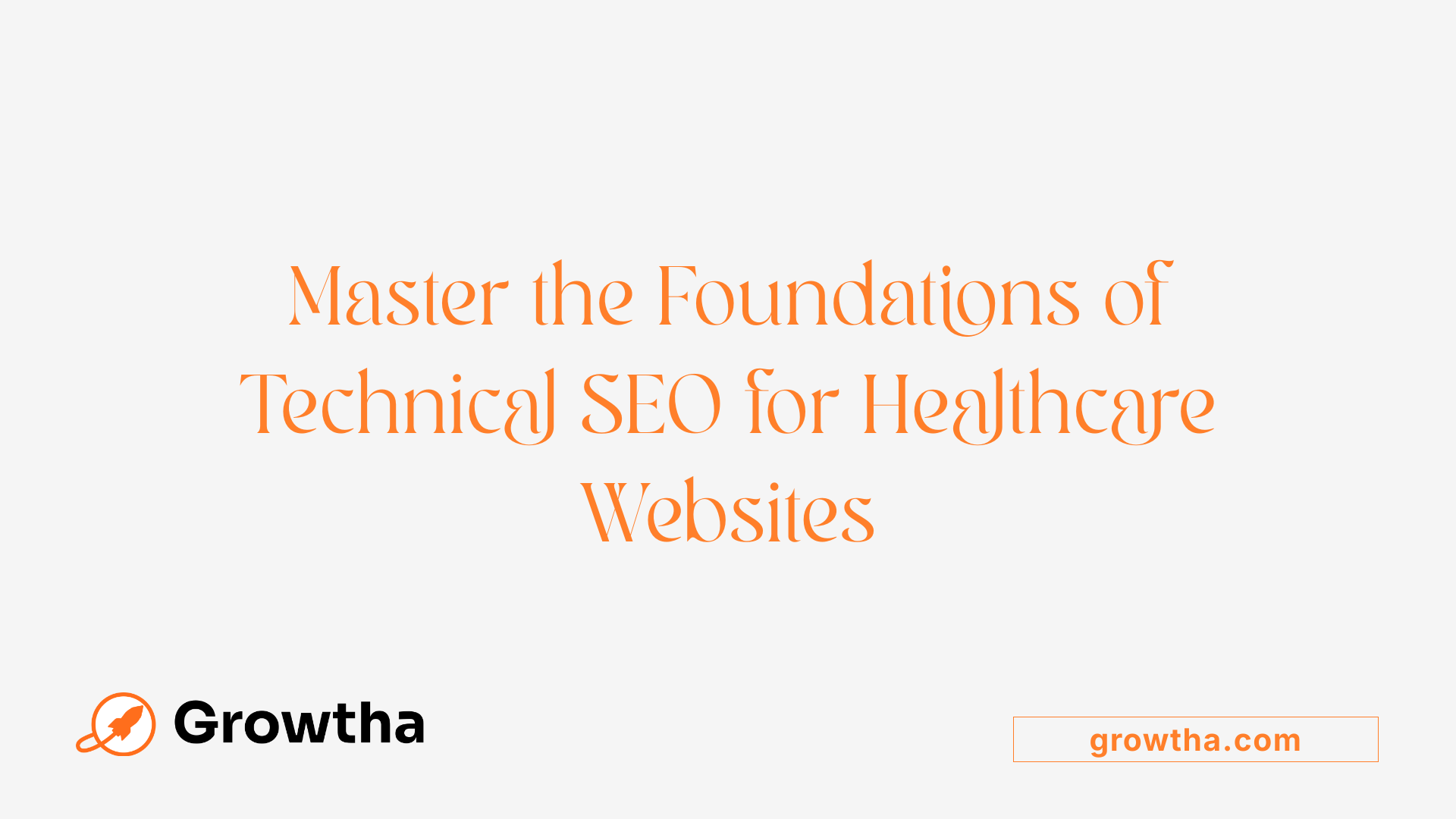How to Audit Your Healthcare Website for SEO
Mastering the Art of Healthcare SEO Optimization


How to Audit Your Healthcare Website for SEO
Understanding the Fundamentals of Healthcare Website SEO Audits
In today’s digital-first healthcare landscape, a robust SEO strategy is essential for attracting and engaging patients online. Conducting thorough SEO audits is a critical step in ensuring your healthcare website is optimized for search engines, user experience, and regulatory compliance. This article explores systematic approaches and best practices for auditing your healthcare website effectively, highlighting key tools, strategies, and compliance considerations.
The Core Purpose and Benefits of SEO Audits in Healthcare
What is the purpose of a content audit?
A content audit serves as a critical process for healthcare organizations aiming to evaluate their existing web content. It helps identify which pages are performing well, which need improvement, and where gaps exist. By systematically reviewing all website content, organizations can ensure that information is accurate, relevant, and aligned with patient needs. Additionally, it uncovers outdated or underperforming material that may hinder user engagement or search engine rankings.
What are the goals of an SEO audit?
The primary goals of an SEO audit in healthcare include assessing website health, optimizing for search engines, and enhancing user experience. It involves a detailed analysis of technical SEO factors such as site structure, page speed, mobile responsiveness, and crawlability. An SEO audit also aims to improve on-page elements like meta titles, descriptions, headers, and keyword usage. Moreover, it evaluates backlink profiles and local SEO efforts to ensure the site ranks well for relevant health-related searches.
How does an SEO audit benefit healthcare providers?
Healthcare providers gain numerous advantages from regular SEO audits. Enhanced visibility in search engine results attracts more local patients, increasing appointment bookings and service inquiries. Audits help identify competitive gaps, allowing providers to target high-traffic keywords effectively. They also improve patient engagement by ensuring content is trustworthy, accurate, and easy to find. Moreover, SEO audits demonstrate marketing ROI through measurable improvements in traffic and rankings.
Why are regular content and SEO audits important?
Frequent audits are essential because healthcare websites operate in a dynamic environment where medical information, regulations, and search algorithms change continuously. Regular evaluations help maintain content relevance, fix technical issues promptly, and adapt SEO strategies to Google’s evolving standards.
What are common issues revealed by audits?
Audits often reveal problems such as outdated information, poor website usability, broken links, slow site speeds, and SEO errors like missing meta tags or poorly structured data. Technical issues such as crawl errors, duplicate content, and security vulnerabilities can also surface. Addressing these issues ensures a trustworthy, compliant, and high-performing healthcare website.
Post-audit activities for healthcare organizations
After an audit, organizations should document findings carefully and develop a structured improvement plan. This includes updating or removing outdated content, optimizing on-page SEO, enhancing site structure, and improving technical performance. Regular implementation of these updates, along with scheduled future audits, ensures sustained online health and effectiveness in reaching patients.
How do SEO and content audits fit into overall healthcare digital strategy?
SEO audits form the backbone of a healthcare organization's digital marketing strategy. They ensure that the website remains compliant with regulations, ranks well for relevant queries, and provides a seamless experience for users. When integrated with broader content strategies, audits help optimize resource allocation, improve patient trust, and bolster online reputation.
| Aspect | Focus Areas | Additional Details |
|---|---|---|
| Content Audit | Relevance, accuracy, gaps, outdated info | Keeps information current and patient-focused |
| SEO Audit | Technical health, on-page SEO, backlinks, local SEO | Improves search engine rankings and local visibility |
| Website Usability | Navigation, speed, mobile responsiveness | Enhances patient experience and engagement |
| Technical SEO | Site structure, crawlability, schema markup | Ensures search engines correctly index the site |
| Ongoing Monitoring | Regular checks, updates, competitor analysis | Keeps the website competitive and optimized over time |
Regularly conducting comprehensive SEO and content audits allows healthcare organizations to stay ahead in search rankings, improve patient trust through high-quality content, and maintain a robust online presence. These efforts ultimately contribute to better patient engagement and successful practice growth.
Critical Elements of a Healthcare SEO Content Audit
What are best practices or checklists for conducting comprehensive website SEO audits?
A thorough SEO audit is essential for healthcare websites aiming to improve visibility and user trust. First, develop a detailed checklist that covers core areas such as technical SEO, on-page factors, content quality, and off-page signals like backlinks.
Start with technical SEO by examining crawlability, fixing crawl errors, and optimizing site structure. Use tools like Screaming Frog or SEMrush to identify issues like broken links or duplicate content. Next, evaluate on-page elements including meta titles, descriptions, headers, and schema markup, ensuring they are keyword-rich and accurately reflect page content.
Assess website performance using Google PageSpeed Insights to improve load times, especially on mobile devices. Check mobile responsiveness with tools like Google's Mobile-Friendly Test and verify site security through HTTPS protocols.
Review content quality by analyzing for duplicates, outdated information, or shallow content. Prioritize adding rich, well-researched medical content that aligns with user intent and medical accuracy.
Off-page SEO involves evaluating backlink profiles, removing toxic links, and earning high-quality backlinks. Track keyword rankings regularly and ensure local SEO strategies, including Google My Business, are optimized.
Monitor user engagement and analytics data from Google Search Console and Analytics to spot patterns and areas for improvement. Document all findings systematically to guide ongoing adjustments.
Finally, keep abreast of algorithm updates and industry best practices, integrating them into your ongoing SEO strategy. Regular audits, conducted at least semi-annually, ensure continuous improvement in search performance and patient engagement.
How often should healthcare websites undergo SEO audits to maintain optimal performance?
Healthcare websites should perform comprehensive SEO audits approximately every six months. This frequency helps catch technical glitches, content issues, or SEO pitfalls early, maintaining search engine visibility and ensuring the site remains aligned with evolving algorithms and healthcare regulations.
Post-restructuring, after launching new features, or following significant algorithm updates, more frequent audits may be necessary. Regular checks also support consistent content refreshes, improve compliance with medical and legal standards, and enhance overall patient experience.
In summary, a biannual SEO audit cycle supports sustained website health, competitive positioning, and effective patient outreach—a vital component of healthcare marketing.
Technical SEO Fundamentals and Tools for Healthcare Websites

What are best practices or checklists for conducting comprehensive website SEO audits?
A thorough SEO audit is essential for maintaining healthcare website visibility and performance. It starts with developing detailed checklists that cover all critical aspects of website health. These include technical SEO, on-page optimization, content quality, backlink profile, and user experience.
Utilize powerful tools such as Screaming Frog, Semrush, Google Search Console, and Google PageSpeed Insights. These help identify crawlability issues, analyze site speed, check structured data implementation, and reveal indexing problems.
Focusing on optimizing core pages with relevant keywords, ensuring proper internal linking, and adding schema markup can enhance visibility and enable rich snippets in search results. Regularly assess user engagement metrics to understand visitor behavior.
Identify and fix broken links, remove low-value pages, and analyze competitor strategies to stay ahead. Consistent documentation of findings allows for strategic planning and prioritization of updates.
Finally, ongoing monitoring through rank tracking, audit tools, and accessibility assessments helps to sustain high SEO standards over time.
What are the key technical components to evaluate during an SEO health check?
An effective SEO health check examines several core technical elements. Site speed is paramount; slow-loading pages harm user experience and rankings. Use tools like Google PageSpeed Insights to identify and implement speed improvements.
Mobile-friendliness is critical, as over half of healthcare website traffic comes from mobile devices. Test with Google’s Mobile-Friendly Test and optimize layouts for smaller screens.
Website security through HTTPS ensures data protection and builds patient trust. Check certificate validity and configure secure protocols.
Structured data, or schema markup, helps search engines understand content, enhancing rich snippet appearances in search results.
Other components include crawl error analysis, duplicate content management, proper URL canonicalization, robots.txt files, and XML sitemaps for proper indexing.
Hreflang tags are necessary for multilingual sites to serve the right language version to users, improving user experience and search relevance.
Evaluating server response times ensures fast loading and better performance. Addressing these components collectively improves crawlability, indexability, and overall search performance while delivering a better user experience for patients.
Enhancing Website Performance and User Experience in Healthcare SEO
What are best practices or checklists for conducting comprehensive website SEO audits?
Performing a full SEO audit for healthcare websites involves multiple key steps. Start by creating detailed checklists that encompass technical SEO, on-page optimization, content evaluation, backlink analysis, and overall user experience. Tools such as Screaming Frog, Semrush, and Google Search Console are invaluable for crawling the website, identifying errors, and analyzing performance.
Key areas to focus on include crawlability, site speed, structured data, and indexing issues. Ensure the website is mobile-friendly, secure (using HTTPS), and free of broken links. Optimizing core pages involves strategic keyword placement, internal linking, and schema markup to improve visibility in search results.
Monitor user engagement metrics like bounce rates and conversion rates, and identify underperforming or outdated content for revision. Additionally, analyzing competitor websites can reveal missing opportunities. Regular performance monitoring through rank tracking, Core Web Vitals assessments, and accessibility audits ensures ongoing improvements.
Document all findings comprehensively, organize them in spreadsheets, and prioritize updates based on potential impact. Set a schedule for periodic reviews to sustain optimal site health.
How important is site speed for healthcare SEO, and how can it be improved?
Site speed plays a vital role in healthcare SEO because it influences search engine rankings, user engagement, and the likelihood of visitors staying on your site. A rapid-loading website enhances user experience, which is particularly crucial for patients seeking quick access to vital health information.
Speed can be improved by optimizing images through compression, enabling browser caching, and minimizing the use of heavy scripts. Utilizing Content Delivery Networks (CDNs) can distribute content more efficiently across various locations, reducing load times.
Tools like Google PageSpeed Insights provide detailed diagnostics and recommended fixes, such as leveraging browser caching, deferring non-essential JavaScript, and optimizing server response times. Implementing these best practices ensures your healthcare site loads swiftly on desktops and mobile devices alike.
Efficiency in site speed not only boosts rankings but also improves conversion rates as visitors are more likely to book appointments or access services on a fast website. Regularly testing and optimizing site speed should be an ongoing part of your healthcare digital strategy.
| Aspect | Details | Additional Notes |
|---|---|---|
| Tools | Google PageSpeed Insights, Search Console, GTmetrix | Used for diagnostics and recommendations |
| Optimization Techniques | Image compression, caching, code minification, CDN use | Focus on all assets impacting load time |
| Impact on SEO | Higher rankings, better user engagement, lower bounce rate | Critical for mobile and local SEO |
| Recommended Frequency | Monthly or after major website updates | Ensures consistent performance improvements |
Understanding and improving website performance is not just a technical upgrade but a strategic move that enhances patient trust and engagement while boosting visibility in search engines. Regularly audit speed and take corrective actions to provide the best possible online healthcare experience.
Building Trust and Authority in Medical SEO

What are best practices or checklists for conducting comprehensive website SEO audits?
Conducting a thorough SEO audit for healthcare websites involves a detailed checklist that covers all aspects influencing search rankings and user experience. First, focus on technical SEO elements such as crawlability, indexation, and site architecture. Use tools like Screaming Frog, Semrush, and Google Search Console to assess and fix crawl errors, broken links, duplicate content, and ensure proper use of canonical tags.
Next, evaluate core on-page elements including title tags, meta descriptions, headers, and schema markup. Optimize pages with relevant healthcare keywords, making sure they are naturally integrated into content and metadata. Check mobile responsiveness with tools like Google’s Mobile-Friendly Test and ensure site speed is optimized using Google PageSpeed Insights.
Content quality is crucial. Regularly review pages for accuracy, relevance, and engagement, updating outdated information and removing low-performing content. Analyze backlink profiles to build authoritative links and disavow toxic backlinks.
User experience assessments include examining site navigation, internal linking, and accessibility standards. Document findings systematically and prioritize corrections based on their impact, resource availability, and SEO value.
Lastly, continuously monitor key performance indicators like organic traffic, bounce rates, and rankings, adjusting strategies as needed to maintain healthy SEO performance. Regular audits are fundamental to sustaining healthcare website success and visibility.
How can healthcare websites implement and improve E-A-T to boost SEO credibility?
Enhancing E-A-T — expertise, authority, and trustworthiness — is vital for healthcare websites aiming for higher search rankings and patient trust. Start by creating high-quality, well-researched content authored by qualified medical professionals. Display staff credentials, biographies, and certifications prominently on the site to demonstrate expertise.
Regularly update content to reflect the latest medical research and guidelines, which shows ongoing authority and reliability. Secure backlinks from reputable sources such as medical journals, professional organizations, and respected health portals to bolster authority.
Implement schema markup for medical content to help search engines better understand and present your information. Incorporate patient reviews and testimonials, which generate trust and demonstrate real-world credibility.
Transparency is key. Provide clear contact information, privacy policies, disclaimers, and adherence to legal standards like HIPAA. Ensuring the site is compliant with healthcare regulations not only boosts compliance but also builds patient confidence.
Finally, maintain active social media presence and community engagement to reinforce your reputation as an authoritative healthcare provider. These practices collectively enhance your website's E-A-T, leading to better rankings in health-related searches.
Optimizing Local SEO and Enhancing Site Structure for Better Visibility

How does local SEO impact healthcare practice visibility, and what are effective strategies?
Local SEO plays a crucial role in increasing the online presence of healthcare providers within their community. When patients search for nearby healthcare services, practices that are optimized for local SEO are more likely to appear prominently in search results, Google Maps, and local directories. This increased visibility can directly lead to higher patient inquiries, appointments, and trust.
Effective local SEO strategies include several essential tactics. Firstly, optimizing the Google My Business (GMB) profile is vital. Ensuring the profile has accurate, up-to-date contact information, office hours, business categories, and high-quality images helps improve ranking signals and builds patient trust.
Secondly, using local keywords within website content, meta descriptions, and headings boosts relevance for geo-specific searches. Incorporating terms like "family medicine in [city]" or "pediatrician near me" aligns content with patient search intent.
Thirdly, maintaining consistent NAP (Name, Address, Phone Number) data across all online platforms and directories ensures search engines and users can easily verify and trust the information. Discrepancies can harm local rankings.
Additionally, developing location-specific pages for each practice site not only improves user experience but also strengthens local SEO. These pages should include localized content, maps, reviews, and clear calls to action.
Moreover, earning backlinks from reputable local organizations, chambers of commerce, and health directories enhances domain authority and local search prominence. Integrating patient reviews on Google and other review sites further boosts credibility and rankings.
Overall, these strategies foster better visibility among prospective patients in the local area, leading to increased foot traffic and service utilization.
How website structure, navigation, and URL hierarchy influence SEO and user experience
An intuitive website structure is fundamental for both search engine indexing and visitor navigation. A well-organized site allows search engines to crawl pages efficiently and understand the relationship between different content sections. For users, clear navigation pathways help find relevant information quickly, improving overall satisfaction.
A logical URL hierarchy should mirror the website’s content architecture. For healthcare practices, this may involve separating pages into categories such as "Services," "Providers," "Locations," and "Patient Resources." URLs should be descriptive, simple, and include targeted keywords, e.g., /services/primary-care or /locations/downtown-clinic.
Navigation menus should be straightforward, with categories and subcategories that reflect user priorities. Sticky headers, breadcrumb trails, and internal links assist users in tracking their location and finding related content.
Proper internal linking distributes page authority and ensures important pages receive adequate link equity. It also helps search engines prioritize indexing of high-value content.
A clean, mobile-friendly design with responsive menus and accessible elements ensures a positive experience across devices, directly influencing rankings via Core Web Vitals.
What are best practices or checklists for conducting comprehensive website SEO audits?
Conducting a thorough SEO audit involves multiple detailed steps. Here is a checklist to guide this process:
Technical SEO:
- Check for crawl errors and fix broken links.
- Assess website speed using tools like Google PageSpeed Insights.
- Ensure mobile responsiveness.
- Verify HTTPS security.
- Review structured data/schema markup implementation.
- Analyze site architecture for logical structure and URL hierarchy.
- Confirm the existence and correctness of XML sitemaps and robots.txt files.
- Check hreflang and canonical tags for duplicate content issues.
- Identify and remove duplicate content.
- Review Core Web Vitals metrics.
On-Page Optimization:
- Optimize meta titles and descriptions for target keywords.
- Ensure headers (H1, H2, H3) properly organize content.
- Incorporate relevant healthcare keywords naturally.
- Improve internal linking and anchor text.
- Use schema markup to enhance search appearance.
- Evaluate and improve content quality and relevance.
Off-Page SEO:
- Analyze backlink profile for quality and toxicity.
- Pursue authoritative backlinks from healthcare directories and publications.
- Maintain consistent NAP data across all listings.
- Encourage and manage patient reviews.
Performance Monitoring:
- Track rankings for target keywords.
- Set up alerts for ranking drops or site issues.
- Use Google Search Console and Analytics for performance data.
Regularly updating this audit process and documenting findings ensures continuous improvement of your healthcare website’s SEO health.
How does content quality influence SEO performance?
High-quality medical content that is original, well-researched, and clearly written significantly enhances search engine rankings. Search engines prioritize content that provides tangible value and shows expertise, especially for YMYL (Your Money Your Life) topics like healthcare.
Creating comprehensive content that addresses patient concerns, common questions, and treatment options builds authority. Incorporating relevant keywords naturally, including long-tail search terms, helps content rank for specific queries.
Additionally, well-structured content with proper headings, bullet points, and visuals improves readability and user engagement. Including staff images, facility photos, and testimonials can boost trust and encourage conversions.
This focus on quality content also increases user dwell time and reduces bounce rates, signals that positively impact SEO rankings. Regular content updates ensure information remains current and accurate, further reinforcing the site’s credibility.
How do technical SEO elements contribute to healthcare website visibility?
Technical SEO ensures that search engines can effectively crawl, index, and understand your healthcare website. Critical elements include website speed, crawlability, mobile optimization, and structured data.
Fast-loading websites improve user experience and are favored in search rankings. Tools like Google PageSpeed Insights provide actionable insights to optimize load times.
Clear site structure, logical URL hierarchy, and proper internal linking facilitate easier crawling and indexing. Using structured data enhances search results with rich snippets like star reviews, FAQs, or service details.
Mobile-friendliness is essential, as over half of visitors access healthcare sites via mobile devices. Google’s Mobile-Friendly Test can verify responsiveness.
Implementing HTTPS ensures security and trustworthiness. Fixing crawl errors, removing duplicate content, and optimizing sitemaps contribute to overall technical health.
What is the role of backlinks and off-page SEO in healthcare website ranking?
Backlinks from reputable healthcare sites, directories, and news outlets amplify domain authority and search ranking signals. An active backlink profile demonstrates credibility and trustworthiness.
Building backlinks can happen through PR efforts, guest articles, and partnerships. Consistent NAP data and positive reviews also contribute to off-page SEO strength.
Toxic backlinks or spammy links can harm ranking; therefore, regular backlink profile reviews and cleanup are essential.
A strong off-page SEO foundation complements on-page efforts, increasing overall online visibility and patient engagement.
| Aspect | Focus Areas | Additional Details |
|---|---|---|
| Local SEO | Google My Business, local keywords, NAP consistency | Ensures practice appears in local search results and maps |
| Website Structure | URL hierarchy, navigation, internal linking | Enhances crawlability and user experience |
| Content | Originality, relevance, keyword integration | Builds authority and ranks higher |
| Technical SEO | Speed, mobile-friendliness, structured data | Facilitates search engine indexing and ranking |
| Backlink Profile | Relevance, quality, toxicity | Boosts domain authority and trust |
| Performance Monitoring | Rankings, Core Web Vitals, analytics | Guides ongoing improvements |
Regular audits within these areas help healthcare providers maintain a robust online presence, reach more patients, and improve overall service quality.
Ensuring Compliance and Building Trust with Website Content

What are best practices or checklists for conducting comprehensive website SEO audits?
A thorough SEO audit is vital to maintaining and improving a healthcare website’s visibility and compliance. Developing a detailed checklist helps ensure all critical areas are addressed systematically.
Start with technical SEO assessment by crawling the site using tools like Screaming Frog or SEMrush. Check for crawl errors, broken links, and indexing issues. Ensure that sitemaps and robots.txt files are properly configured. Evaluate page speed using Google PageSpeed Insights, focusing on core web vitals such as load times and interactivity.
Next, review on-page elements including title tags, meta descriptions, headers, and schema markup to optimize key pages with relevant healthcare keywords. Verify that content is unique, accurate, and engaging.
Assess user experience by testing mobile responsiveness, navigation structure, and accessibility standards. Confirm that the site is secure by checking SSL certification.
Analyze the backlink profile using tools like Ahrefs or Moz to identify reputable links and remove toxic backlinks. Monitor website analytics to identify high-performing pages and content gaps.
Finally, compare your findings against competitor strategies, and regularly update your audit to incorporate new SEO trends and guidelines. Documentation and prioritization of issues help set actionable goals for ongoing improvement.
How do healthcare sites ensure compliance with medical advertising standards and privacy regulations while optimizing for SEO?
Maintaining legal compliance is essential in healthcare marketing. First, include comprehensive privacy policies and disclaimers on all pages clearly outlining data collection and usage, especially for contact forms and appointment scheduling.
Adhere to HIPAA and other local privacy legislation by securing patient information through encryption and secure form handling. Display contact details prominently and maintain consistency with NAP (Name, Address, Phone) data for local SEO.
To build trustworthiness, cite sources for medical claims, include professional credentials of staff, and showcase reviews and testimonials ethically. Use structured data (schema.org) to enhance search listings while avoiding markup that could violate guidelines.
Regularly review legal compliance documentation and stay updated on changes in healthcare marketing regulations. This ongoing audit ensures that content remains trustworthy and authoritative, which aligns well with SEO best practices.
Employ transparent, accurate content and avoid overpromising or sensationalizing medical information to uphold ethical standards.
Closing Tips for Balancing SEO and Regulatory Standards
- Use clear, straightforward language with proper medical citations.
- Incorporate schema markup for healthcare providers and conditions.
- Ensure mobile-friendly design for better usability and ranking.
- Avoid keyword stuffing; focus on natural, relevant keyword integration.
- Keep content updated to reflect current medical guidelines and regulations.
- Regularly verify that all legal disclaimers, privacy notices, and contact information are accurate and visible.
| Aspect | Focus Area | Importance |
|---|---|---|
| Technical SEO | Crawlability, site speed, structured data, security | Foundation for search engine indexing and user trust |
| Content | Accuracy, originality, keyword relevance | Higher rankings and user engagement |
| Legal & Privacy | Disclaimers, privacy policies, HIPAA compliance | Trustworthiness and legal adherence |
| User Experience | Mobile responsiveness, navigation, accessibility | Patient satisfaction and retention |
| Backlink Profile | Quality of backlinks, removal of toxic links | Official recognition and authority boost |
Regular audits exemplify a commitment to continuous improvement—updating content, refining SEO strategies, and ensuring compliance—ultimately fostering trust with users and search engines alike.
Integrating Ongoing Monitoring and Future Strategies for SEO

How do healthcare organizations develop and implement an effective ongoing SEO monitoring plan?
Healthcare organizations need a structured approach to keep their SEO efforts effective over time. Developing an ongoing SEO monitoring plan begins with setting clear, measurable goals such as improving search rankings, increasing organic traffic, or boosting patient inquiries.
Key performance indicators (KPIs) include search engine rankings, website traffic, bounce rates, and conversion rates—metrics that directly reflect the effectiveness of SEO strategies.
Next, utilize tools like Google Analytics, Google Search Console, SEMrush, and specialized platforms such as Siteimprove for continuous data collection and analysis. These tools provide real-time insights into site performance, user behavior, and technical health.
Establish a routine review schedule, typically monthly or quarterly, where you analyze performance trends. During these reviews, focus on identifying issues like crawl errors, security vulnerabilities, or lost backlinks. Make adjustments based on data—for example, updating content, fixing technical flaws, or refining keyword strategies.
It's also important to stay informed about competitors' SEO moves and search engine algorithm updates. Regular audits of your site can reveal new opportunities and threats, helping you adapt proactively.
Furthermore, automate where possible. Set up alerts for significant changes in rankings or site errors to address issues promptly.
By integrating these processes into a continuous workflow, healthcare organizations can maintain and enhance their search visibility, ensuring their digital presence effectively supports patient engagement and organizational goals.
What are best practices or checklists for conducting comprehensive website SEO audits?
A thorough SEO audit begins with developing a detailed checklist covering all critical aspects of website health. This includes technical SEO, on-page optimization, content quality, backlink profile, and user experience.
Start by analyzing crawlability and indexing issues with tools like Screaming Frog, Semrush, or Google Search Console. Check that all pages are accessible, free of errors such as 404 or 500 responses, and properly indexed.
Evaluate site speed and mobile responsiveness using Google PageSpeed Insights and Mobile-Friendly Test. Faster, mobile-optimized sites rank better and provide a better user experience.
Review on-page elements—titles, meta descriptions, headers, and structured data—to ensure they are relevant, well-optimized, and free of duplicates. Focus on targeted healthcare keywords, including long-tail phrases.
Assess internal linking structures to ensure logical navigation paths and to distribute link equity effectively. Identify orphaned pages or underlinked content.
Examine off-page factors, especially backlinks, to identify high-quality links and toxic spam. Use tools like Ahrefs or SEMrush for backlink analysis.
Finally, generate performance reports covering core Web Vitals, rankings, and engagement metrics. Use this data to prioritize improvements, update outdated content, and fix technical issues.
Regularly repeating this audit, and documenting findings in a structured manner, helps maintain a healthy, competitive healthcare website.
How can healthcare organizations develop and implement an effective ongoing SEO monitoring plan?
Establishing an ongoing SEO monitoring plan requires a combination of goal setting, tool utilization, regular reviews, and agile responses. Define clear KPIs—such as improved rankings for targeted keywords, increased organic traffic, or higher patient inquiry conversions.
Leverage monitoring tools like Google Analytics for traffic insights, Search Console for indexing and technical issues, SEMrush for keyword tracking, and Siteimprove for site health assessments. Set up custom dashboards and alerts for critical metrics.
Schedule consistent review intervals—monthly or quarterly—to evaluate these metrics comprehensively. Look for patterns, sudden drops, or improvements that indicate success or problems.
Include routine technical audits to identify crawl issues, broken links, or security breaches. Continually refine content strategies, update outdated pages, and expand on high-performing topics.
Keep an eye on competitors’ strategies by analyzing their keyword performance and backlink profiles, adapting your tactics accordingly.
Monitoring should also include checking compliance with privacy and security standards, especially concerning patient data, and updating content to reflect new medical guidelines.
Establish workflows for rapid issue resolution—like fixing crawl errors or removing spammy backlinks—to prevent minor issues from escalating.
By regularly analyzing performance data and adjusting tactics, healthcare providers can sustain and grow their SEO success over time, ensuring they attract new patients and retain trust in their digital presence.
Implementing a Continuous SEO Strategy in Healthcare
An effective SEO audit is the foundation of a successful healthcare website strategy, helping identify issues, optimize content, and improve site performance. Regular audits ensure compliance with legal standards, enhance user experience, and boost search engine rankings. By leveraging specialized tools, adhering to healthcare-specific SEO best practices, and conducting systematic reviews, healthcare organizations can maintain and improve their online visibility. Embracing a culture of ongoing monitoring and continuous improvement is vital for staying competitive in the digital healthcare landscape, ensuring that your website effectively connects patients with the services they need.
References
- The Healthcare Content Audit Explained - Aha Media Group
- Healthcare SEO: 12 Expert Medical SEO Tactics
- How to improve healthcare web content with targeted audits
- SEO site audit: Your step-by-step guide - Siteimprove
- How to Do an SEO Health Check for Your Website [+ Checklist]
- How to Achieve Website Health with an SEO Audit - FieldRoutes
- How To Conduct a Health System Website Audit (and Why It Matters)







